Quick Tips for Homeschool Scheduling
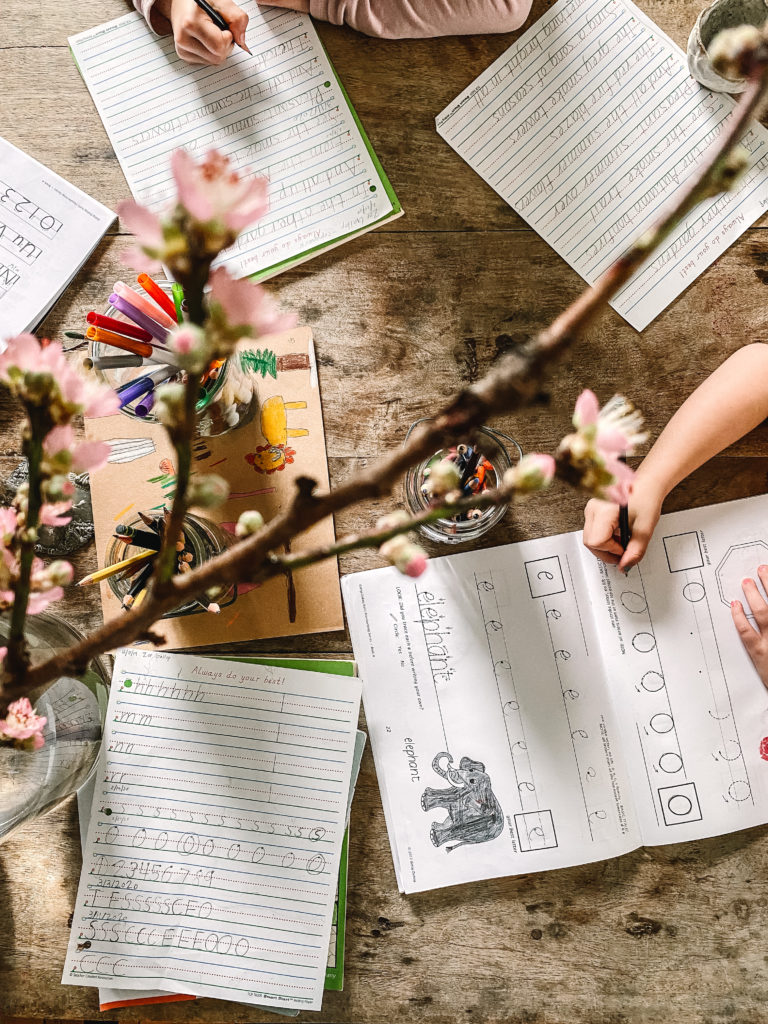
Wow! Recent events (I’m talking about you, COVID-19) have left around 1.6 BILLION out of school. Some parents have been directed to continue their education from home and have been provided a small “packet” of information and schoolwork, or have been given nothing. I have received countless requests for some kind of a “homeschool guide” to help first-time homeschoolers figure out how to make a daily homeschool schedule and generally just navigate homeschooling. And so, I spent the past day putting together this little guide: “Quick Tips for Homeschool Scheduling” (you can download the guide as a pdf if you click here).
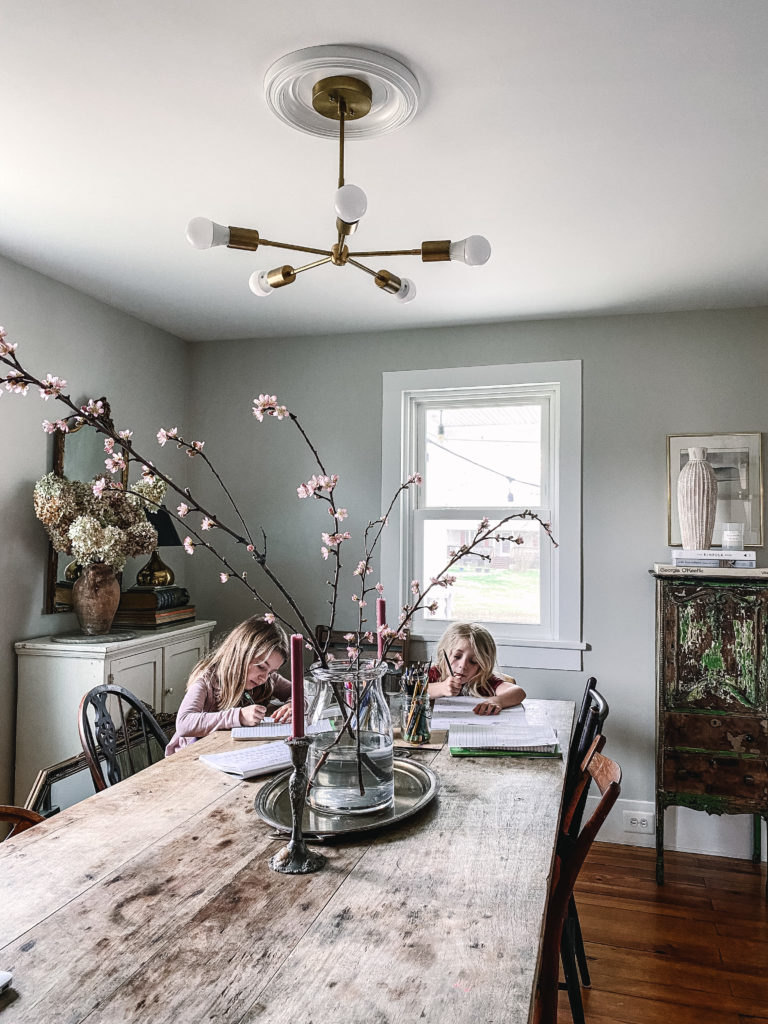
Quick Tips for Homeschool Scheduling:
Managing Your Time
- Spend a half hour after the kids go to bed in the evening, or before they wake up in the morning, reviewing what they will be learning in the coming day.
- Set up a daily schedule that works with your family, while embracing the leisure that this situation allows.
- Take breaks when needed: play outside, color, watch an educational video.
- If a child is extremely frustrated over a subject, feel free to end the lesson early, or switch to another subject for a while. Just make sure you’ve given the problem all of your patience and persistence first.
- Do what is required of you from the school district, but then allow children to pursue individual interests, outside play, etc.
- Don’t feel pressured to spend an hour on every subject. By nature, a traditional classroom setting will require a longer period of instruction for each lesson. In homeschooling, you’re able to complete each subject in a much shorter period of time.
Keeping Things Under Control
- Set up a system so your child knows what you expect each day.
- If you have multiple children, consider using table dividers to keep them in their own space.
- Break it up: snacks, dance parties, walk outside, board game, whatever motivates them.
- Make it fun! Sing, dance, incentivize.
- Don’t be afraid to offer both negative and positive incentives. Lose a privilege if they complete schoolwork, receive a reward if they do. Rewards/treats should be small enough to use on a daily basis, and it’s nice if you vary them.
- As with any discipline, you must stick to what you say, or it won’t work! Be consistent and don’t give in; you’re the teacher and they must learn to respect you!
Figuring Out What to Prioritize
- Use tools and lesson plans provided by your school.
- If you haven’t received anything from the school, focus on math and language arts, long with plenty of family read aloud time. (Free curriculum & resources are listed below!)
- Don’t feel pressured to give a long lesson/lecture for each subject. Children can learn well by receiving a short summary and then engaging with the material through homework. If they encounter something they don’t understand, go back and review in more detail.
- Supplement with time spent outdoors, nature study, physical exercise.
- Use this unstructured time to allow your students to pursue individual interests: writing a book, a unit study on bears, science experiments, etc.
- Children thrive on extra responsibility. This doesn’t mean extra chores. This means trusting them with things that go slightly beyond the capabilities they have. For a six-year-old, try responsibilities like reading to younger siblings, setting the table, making breakfast, or planting seeds.
Navigating Screen Time
- If you allow screen time, try to make it profitable, and limit daytime TV.
- Our two favorite television shows for children are 1) The Cat in the Hat Knows a Lot About That (available through Netflix): entertaining, well-made episodes that teach about animals and habitats in a captivating way; 2) Stella and Sam (available through Amazon Prime): beautiful stories about a big sister and her little brother with lovely animation and imaginative play.
- If you have Amazon Fire TV, there are a bunch of great phonics and early reading apps made by Dezol. “Sight Word Search” and “Learn Beginning Sounds” are two that we’ve found very effective and nonsense free.
- There are a plethora of gorgeous animal and nature documentaries available through most streaming services.
- Don’t feel guilty. If these days get super tough, don’t feel bad about letting the kids watch an evening movie to calm them down and give yourself a little time to recover.
Sample Daily Homeschool Schedule
6:00 – 8:00 – Kids in bed, mom works
8:00 – Everyone up, dressed, beds & rooms tidied
8:30 – Breakfast, cleanup
9:15 – Morning walk, or exercise indoors
10:00 – Morning school (no screen time)
11:30 – Outside break, or indoor play
12:00 – Lunch, cleanup
1:00 – Chores
1:30 – Afternoon school (educational screen time)
3:00 – Quiet/creative time, mom works
4:30 – Outside time, or indoor play
5:30 – Dinner prep, dinner, cleanup
7:00 – Tidy house/catch up/showers/free time
8:30 – Bedtime
9:00 – Mom works, prep for tomorrow
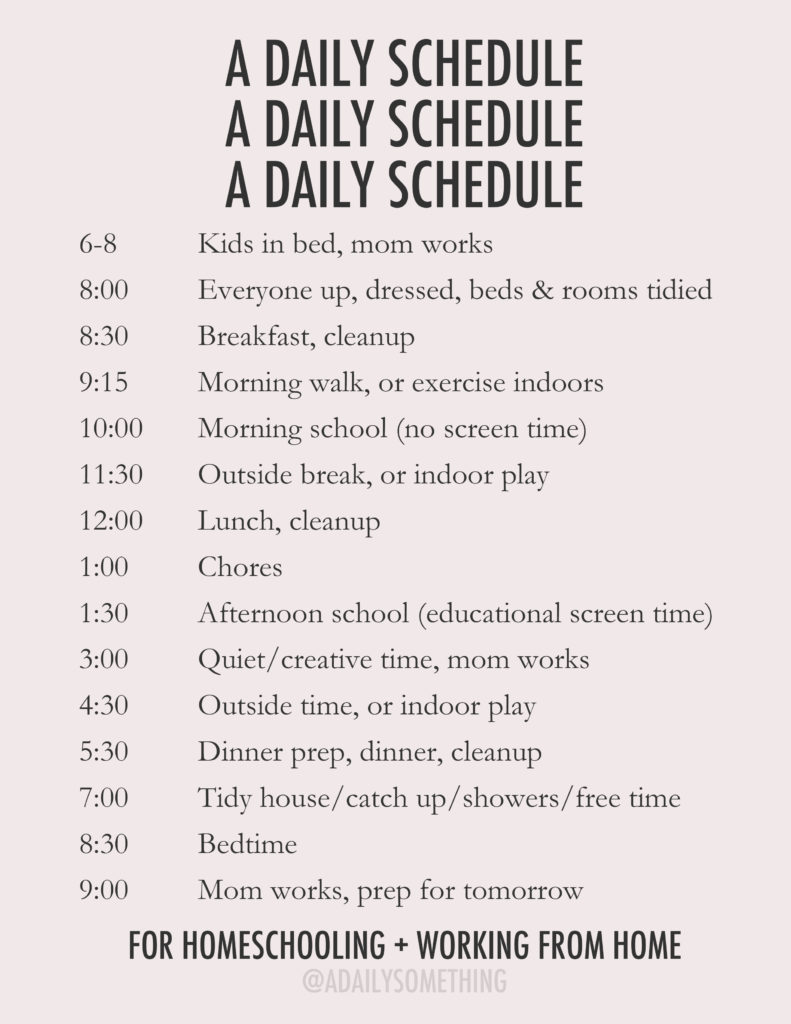
How To Use These Quick Tips for Homeschool Scheduling:
Joe and I have been officially homeschooling our children for two years now. I consider us “veteran” homeschoolers, though, because we have over 17 years of combined homeschool experience, as we were both homeschooled for most of our primary and secondary education. We’ve seen a lot and learned a lot from our parents’ (and our own) trials and triumphs.
Please take this little guide with a grain of salt. It’s not intended to be a homeschooling “Bible” but rather a starting point. It’s a lighthearted and practical guide for those who don’t know where to start. If you find yourself suddenly needing to provide home education for your children and come up with some sort of homeschool schedule, my hope is that you will be encouraged by this guide. That it will help you determine what your homeschool schedule will be. That you will walk away feeling positive and encouraged. And that you will know where to look for additional support and resources.
Here are some of our favorite homeschool supplies, resources, and groups.
Homeschool Supplies:
- Homeschool Supplies: These are some of our favorite homeschool supplies and books, all available on Amazon
Homeschool Support/Groups:
- HSLDA: Homes School Legal Defense Association provides legal representation for homeschoolers, many resources and forms, summaries of legal requirements by state, an international section, and more.
- Wild and Free: A beautiful community with an emphasis on encouraging children to “experience the adventure, freedom, and wonder of childhood.”
- Homeschool Foundation: Helping families homeschool through hard times. They have a list of free or inexpensive curriculum.
Homeschool Curriculum/Classes:
- Ambleside Online: A free homeschool curriculum that uses Charlotte Mason’s classically-based principles; I love their book lists for each year.
- Outschool: A resource for interest-based education.
- CTC Math: A math program we’re just starting to use as a supplement for our children, $150/year for the entire family.
- Other Goose: A beautiful homeschool curriculum for ages 2-7, delivered to your inbox monthly.
- Peaceful Press: One of the first curriculums I used for preschool. I love the simplicity.
- Khan Academy: Free online classes.
Free Books:
- Libravox: Free public domain audiobooks.
- Project Gutenberg: Free e-texts available for download.
- ManyBooks: Free e-texts available for download.
- Archive.org: A non-profit library with millions of free books, movies, software, music, websites, and more.
Please let me know if you have any questions about homeschooling or have other content you’d like to see; I’ll do my best to find the answer! And enjoy this wonderful new journey! Read more about our homeschool journey and philosophy. And you can read more about my life as a Work-From-Home mom!
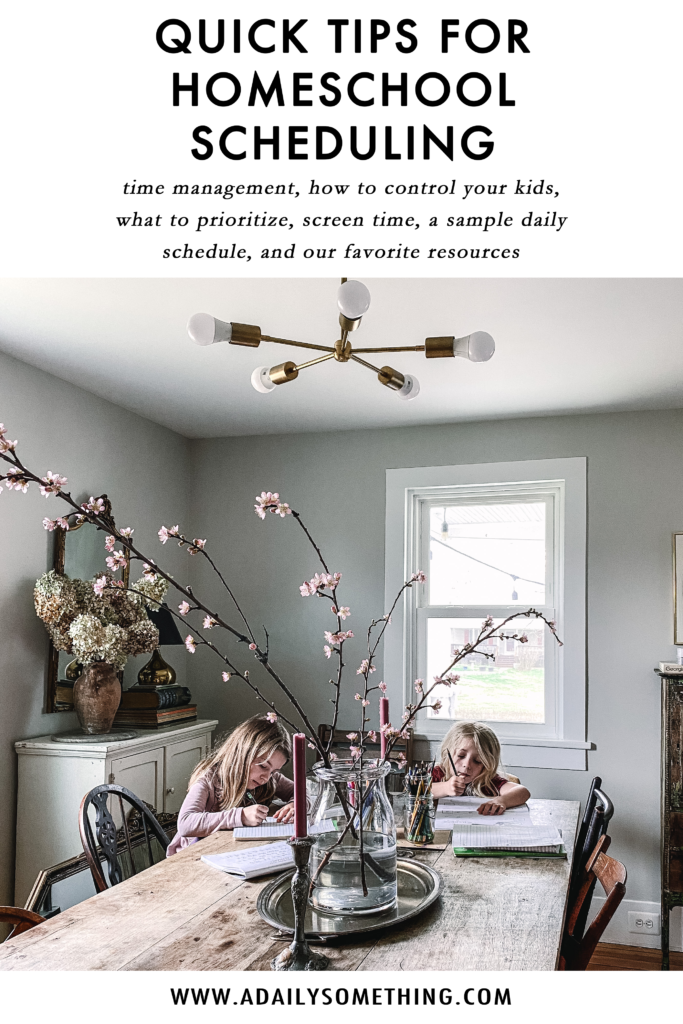
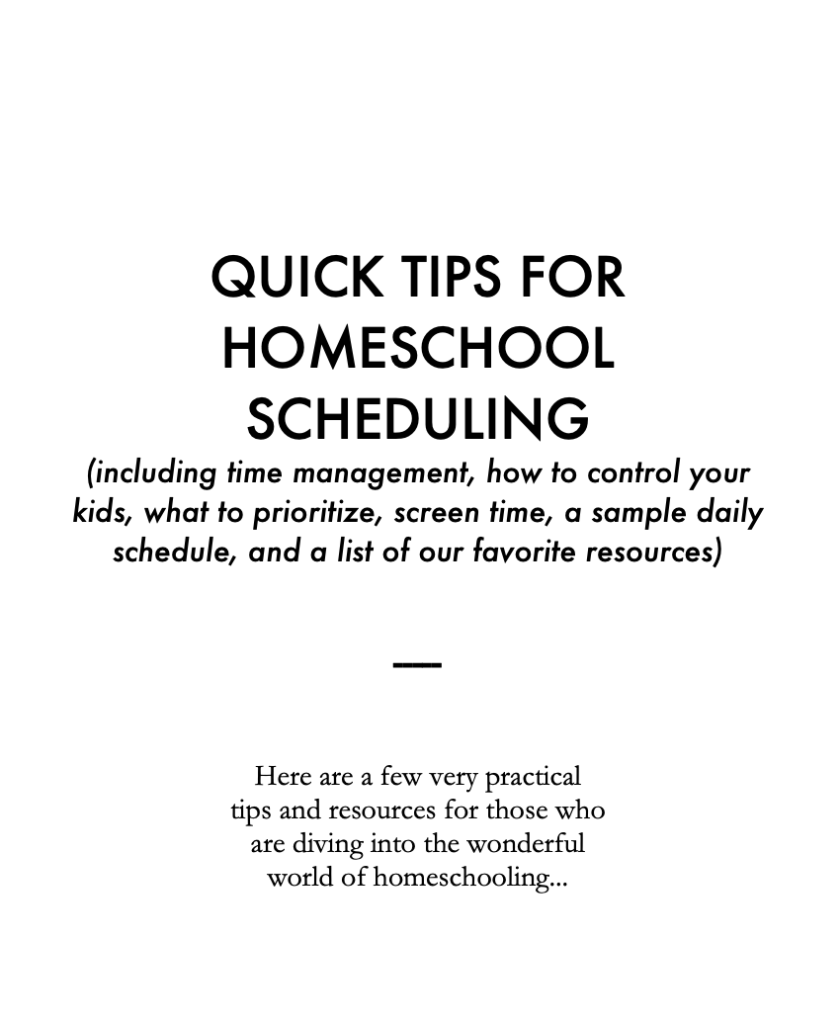
Leave a Reply
PREVIOUS POST:
NEXT POST:
Disclosure.
Discovering how to infuse our lives—ourselves, our work, our relationships, our homes, and our entertaining spaces—with simple beauty, more intention, and slow living principles.
Interested in working together?
Click here to visit the Contact page and get in touch.
PORTFOLIO
© 2020 A Daily Something — All Rights Reserved.
Design by TONIC.
Learn more about A Daily Something styling services, content creation offerings and view curated work.
CONTACT + COLLABORATE
MANIFESTO
Join the list to receive our thoughtful monthly letters, and to be the first to know of upcoming workshops, dinners, gatherings, and more.
SUBSCRIBE
ALL PHOTOS AND IMAGES ON A DAILY SOMETHING ARE BY A DAILY SOMETHING UNLESS OTHERWISE NOTED. IF YOU SEE AN IMAGE THAT IS NOT PROPERLY SOURCED, PLEASE LET US KNOW AND WE'LL UPDATE THE INFORMATION! IF YOU WOULD LIKE TO SHARE A PHOTO OR TUTORIAL FROM A DAILY SOMETHING, PLEASE ONLY SHARE ONE PHOTO, WHICH MUST BE CREDITED AND LINKED BACK TO A DAILY SOMETHING.
SPONSORED POSTS WILL ALWAYS BE DISCLOSED AND ANY GIFTED ITEMS WILL BE MARKED C/O. WE ONLY WORK WITH COMPANIES THAT ARE A GOOD FIT FOR THE A DAILY SOMETHING AESTHETIC AND CONTENT. THANK YOU FOR SUPPORTING THE COMPANIES THAT ENABLE US TO CONTINUE PRODUCING QUALITY CONTENT.
[…] this year I put together some Quick Tips for Homeschool Scheduling and today I’m sharing 5 Things To Do Before You Start Homeschooling. We recently received the […]